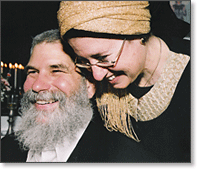Bread - The Staff Of Life
Let's try
investigating who might be the primary suspect in the page turning life and
death mystery whodunit set in Gan Eden. Many commentators have debated what
might have been the real identity of the proverbial apple fed by Eve to Adam.
Some say that the troublesome fruit was grapes and so the excuse for not
following orders was that they were DUI. Others claim it was a fig, note the
beginnings of the rag trade and multi-billion $ fashion industry was fig
leaves. Still others say it must have been wheat because a baby can’t speak
intelligently and say abba, eema until they’ve tasted wheat so that must be the
“tree” of knowledge. We all know that the best way to a man’s heart is through
his stomach. Like my mother of blessed memory used to council me – don’t ask
for anything from your father when he first comes home from work, wait till he
sits down and has a nice dinner before you hit him up. That’s what I call
Chochmat Nashim – women’s wisdom.
INGREDIENTS:
Whether it is wheat, barley, spelt, rye & oats one of
these 5 grains must be the major component of the substance we call bread upon
which we can recite the Hamotzei Lechem Min Haaretz blessing. At classes with
Rabbi Yitzchak Ginsburgh at Kever Rachel in Beit Lechem – The House of Bread,
we learned that the women have kept the tradition of what those obscure grains
might actually be today and we can trust our ladies to remember correctly. The grains
must be pulverized into flour
to resemble the dust of the earth which Hashem used to mix with the dew that
rose up from the garden floor and kneaded into the hunk of dough called man. So
there’s your second major component – water.
If the dough is made with juice it’s not called “bread” and gets the mezonot
bracha.
“Tov shem m’shemen tov,” (Kohelet 7:1), better a good name
than the most extra virgin olive oil.
We discovered an ancient Byzantian oil press in our front yard
back in 1976 when we first moved to the moshav. We helped the Antiquities
Department dig up the dig whose artifacts were carted off to the Rockefeller
museum in East Jerusalem. Life on the moshav
was very challenging in the early days of sporadic water supplies no phones and
quiet isolation.
Paradoxically the more you crush an olive the more lovely
oil it can produce. Isn’t that the diametric opposite of western striving for
the “good life” = easy life? The oil of affliction softens our thick skin,
making us sensitive to others suffering, lights up the darkest night of
Chanukah and lightens our challah. The egg
is a symbol of the cycles of life and death the first food served to a
mourner after a funeral and the last food eaten before the fast of Tisha B’av,
round and round we go. We make round challah with sweet raisins for a sweet New Year.
Hamtakat Hadinim, sweetening the judgment by adding a little
brown sugar
& honey to
the yeast
mixture otherwise the yeastie beasties can’t grow and bubble and do their job
of lifting and uplifting. Simcha is like the sweetness of spirit that
makes us rise up out of our sluggish laziness. Rise up, get going! Put on some
Jewish music with a nice steady rhythm, Reb Shlomo’s Mizmor Shir Le'Yom
Hashabbos is a great one for kneading the challah.
Mix 1½ cups warm water with 2 teaspoons yeast and ¼ cup
brown sugar and watch it bubble up. Add one egg, three tablespoons of oil and
approximately 5 cups of flour, best a mixture of white and whole wheat add 2
teaspoons of salt and knead into soft elastic dough. We need to stay open and
stretch ourselves to share our bounty with our many guests every week. To say
the bracha on separating the “challah” we must have a total of 2.2 kilo or 5
pounds of flour which we get if we make 3 batches of dough.
 |
| Trying out a four braid with Young Judea Year Course students |


Wonderful, Inspiring, & Please re-Ad me to your list. לשנה טובה תיכתיבו ותחתימו- מטובה סילבר בבוםטון-
ReplyDelete